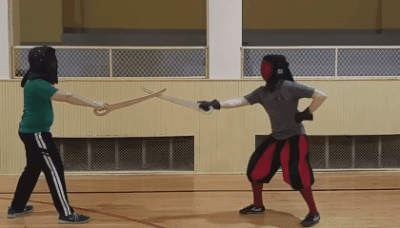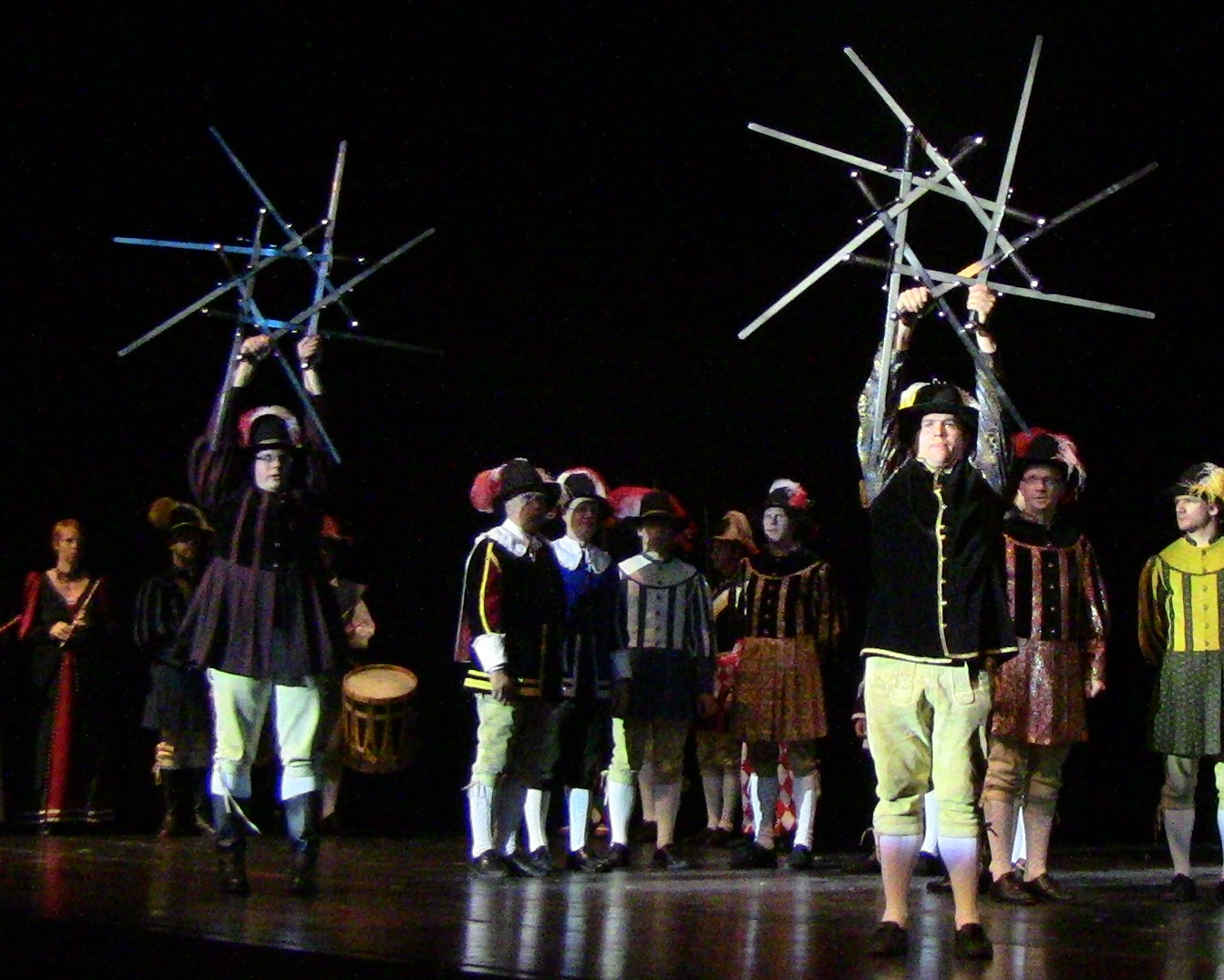A couple of weeks ago I had shared with me this great image depicting a fechtschul in Zwickau in 1573. Within the text on the left of the page it name-drops a few noblemen and dukes, some of whom I have found named in my own research on Strasbourg fechtmeisters. One of them is “Duke Prince-Elector August”, who is named in a 1587 note in the Strasbourg archives that states Lienhardt Sollinger was a former follower of his (you can read more about Lienhardt and his fencing wife here).
What’s notable about this Zwickau picture is it shows that August was a fan of fencing much earlier than the Sollinger note. This gave me more fuel to search for fencing-related notes involving the Prince-Elector, and this fire was only stoked by the fact that August ruled over the Electorate of Saxony from Dresden -- the birthplace of our boy Wygand Brack. If Brack fenced before moving to Strasbourg, and if August was a sword nerd even before 1573, maybe I could dig something up naming Brack before he moved to Strassy.
Unfortunately the Saxon state archives are much more difficult to navigate and search through than Strasbourg’s, but I was able to manually locate an account of a fechtschul and sword dance sponsored by Prince-Elector August in 1554. Below is a translation of the document, interspersed with tidbits and commentary on the text. A full transcription of the German text with its accompanying English translation are available at this link.
The Fechtschule and Sword Dance
And on this day 13 races or rounds of shooting happened.
Between the same, before noon, a fechtschule with all kinds of weapons, and after noon, a sword dance were held.
Then His Electoral Grace had many days before this ordered a landsknecht captain, Hans Jung of Chemnitz, and a citizen of Dresden, Hans Pfalh, to compete so they might gather fencers on the shooting range who are known for jolly cooperation.
The “shooting range” or “Schießplatz”, which appears frequently in this note, may refer to either a musket range or a crossbow range.
To those among them who [??] the best, His Electoral Grace wished to decree a sizable reward, just as Hans Pfalh had been given twenty talers for providing such knightly art and entertainment. Following this, in the morning, between the races, many kinds of short and long weapons and polearms were laid down.
Namely four pairs of side-swords, ten pairs of wooden dusacks, a pair of daggers, two pairs of quarterstaves, one pair of long spears and one paratschwert.
The swords are identified as “Behrschwerter”, literally “carry-swords”. We chose the translation “side-sword” as given the spread of weapons also named within this grouping it most likely refers to the proto-rapiers or “Meyer rappiers” we are familiar with in HEMA, which are depicted in the 1573 Zwickau image below.
There was also a fencing master named Dix [= Benedict] Pein from Stolpen. But the captain Hans Junge and Hans Pfalh, as those in charge, assisted as military supervisors. And although in the beginning many fencers - out of all kinds of journeymen - had distinguished themselves, also conducted themselves elegantly with the dusack, with bloodless strikes:
When it had been made known to them, according to the Electoral order, that no one should be given a prize, except when he had struck his opponent bloody or in such a way that one could readily see the strike; some of the fencers disappeared and maybe feared for their skin. Nobody was particularly bloody except the reported fechtmeister who had blood smeared twice over his head.
This is a particularly interesting passage. We know from the Strasbourg research that all types of journeymen and young professionals participated in fencing, and so this statement is not surprising. However, it seems to imply that most of the fencers were not exactly…giving it their all, and once someone in charge tells them “no blood, no money,” a bunch of fencers back out. The scoring metric of “highest mark” or hit to the head is consistent with the fencing conventions of the time.
Nonetheless, so that the fencers might not think that one had made them false hopes with the prize, those in charge gave to the following persons, regardless of how they had honored the command of [His] Electoral Grace. But many of the dussacks had remained in one piece.
Perhaps this last sentence alludes to the fencers getting paid out, although they did not fence with the level of gumption or ferocity that the Electoral Grace would have expected, which would result in more weapons being destroyed. Although our typical modern leather trainers don’t break often, it’s not difficult to crack a wooden one.

Hans Gar of Konzell - 2 talers
To the same in the dussack - 2 talers
Sigmund Fischer of Landshut - 2 talers
In the sword
Mattes von Wind[e?]sheim - 2 talers
In the sword
Baltassar von der Freystat - 2 talers
In the dussack
Stenzel Schumann of Konzell - 2 talers
In the dussack
Christoff Dros - 1 taler
Michel Linsenhauer - 1 taler
Benedix Pein, fencing master from Stolpen, because he was struck twice - 2 talers.
Total of the distributed prizes: 16 talers.
Money for fencing! For a bit of context, the monthly wage for a stonecutter in a contemporary set of sources from Styria was about 2.5 taler, and 1 thaler would get you 57.6 pounds of pork or mutton at Graz in 1557. Not bad for just an afternoon’s competition and a little head trauma!
After these prizes are awarded, some of the same fencers get all dressed up and hold a sword dance, or schwerttanz, with some details about how it was done.
In the afternoon, the aforementioned Hans Pfalz, with thirty persons - sons of citizens and journeymen - who had been instructed many days before and trained, arrived on the (shooting) range with drums and pipes.
The Illustrious Prince-Elector had arranged for them to be dressed out of His Electoral Grace’s tailory workshop, one just like the other, in resin-pickers’ smocks and fine clothes, trimmed colorfully with beautiful red and white linen.
And all walked one after the other in a row, each one had a naked sword over their armpit and held their neighbor’s sword with the other hand, to dance the sword dance in front of the marksmen.
As soon as a race was completed, they began the sword dance, and Hans Pfalh and Christoff Tros led the same, Georg Schumann danced last. These three persons, as the first, the second and the last, guided the dance for the most part. Firstly, [they] led the dancers into the circle and back out again, they had them duck and jump over the bridges made with the swords, above, below and criss-cross. Afterwards they also let the star be shot in two manners, and many antics were performed, according to the style and tradition of this dance.
There are many modern recreations of these sword dances (here’s an example) which contain some of the elements named here, such as jumping over and ducking under “bridges” of swords, and holding each other's swords as they circle around. The most odd part is the mention of “...let the star be shot in two manners…” which, I hypothesize, might possibly refer to the dancers allowing the marksmen they are performing in front of literally shoot through star-patterned locked swords held aloft.
But since the dance couldn’t be performed with all (its) pieces in-between a round of shooting, the dancers - when one had finished the bolts in the office tent - meanwhile danced into a tent.
As soon as the (shooting) range became empty again, they scampered out, until they had brought the same (their dance) to a close.
With this entertainment the day had passed.
It seems that either the dancers timing was off, or the scheduling was horrible, and they got interrupted before they could finish their routine.
Although not containing anything particularly earth-shattering, and sadly not including Brack in the list of participants, this entry provides some interesting nuggets of information around fencing in Meyer’s era. From some fencers backing out when the fencing got a little too hardcore for them, or actual prize values given out, this short piece adds more to the image of fencing in the 16th century.
Thank You
Big thanks to Platy for your assistance in correcting the transcription and translation, and adding some historical context and ideas, especially around taler values for the times.




